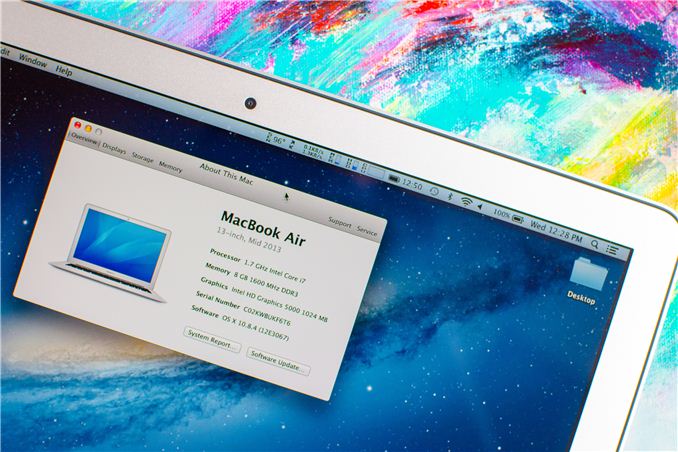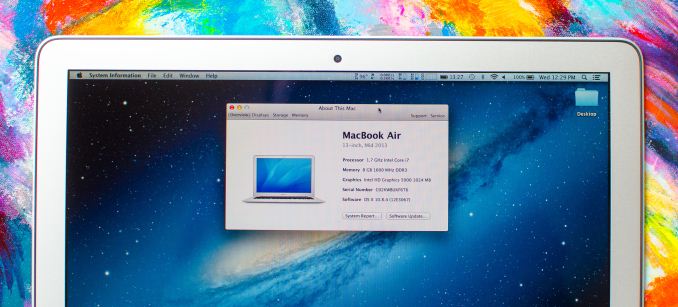The 2013 MacBook Air: Core i5-4250U vs. Core i7-4650U
by Anand Lal Shimpi on July 4, 2013 8:00 AM EST
Apple typically offers three different CPU upgrades in its portable Macs: the base CPU, one that comes with the upgraded SKU and a third BTO option that's even faster. In the case of the 2013 MacBook Air, Apple only offered two: a standard SKU (Core i5-4250U) and a BTO-only upgrade (Core i7-4650U). As we found in our initial review of the 2013 MacBook Air, the default Core i5 option ranged between substantially slower than last year's model to a hair quicker. The explanation was simple: with a lower base clock (1.3GHz), a lower TDP (15W vs. 17W) and more components sharing that TDP (CPU/GPU/PCH vs. just CPU/GPU), the default Core i5 CPU couldn't always keep up with last year's CPU.
For most users upgrading from an older machine the regression won't matter. The 2013 MBA includes a much faster SSD, better graphics, and better CPU performance compared to older MBAs as well. For those users who are either trying to make an ultraportable more of a workhorse, or who otherwise need more performance than last year's MBA can offer there is one solution. The BTO upgrade increases the base clock to 1.7GHz, adds an extra 1MB of L3 cache and includes much higher turbo frequencies:
| Apple 2013 MacBook Air CPU Comparison | |||||
| 1.3GHz dual-core | 1.7GHz dual-core | ||||
| Standard On | 11 & 13-inch MBA | Optional on Both | |||
| Intel Model | Core i5-4250U | Core i7-4650U | |||
| Base Clock Speed | 1.3GHz | 1.7GHz | |||
| Max SC Turbo | 2.6GHz | 3.3GHz | |||
| Max DC Turbo | 2.3GHz | 2.9GHz | |||
| L3 Cache | 3MB | 4MB | |||
| TSX-NI | No | Yes | |||
| TXT | No | Yes | |||
| AES-NI | Yes | Yes | |||
| VT-x/VT-x EPT | Yes | Yes | |||
| VT-d | Yes | Yes | |||
| TDP | 15W | 15W | |||
| Processor Graphics | Intel HD 5000 | Intel HD 5000 | |||
| GPU Clock (Base/Max) | 200/1000MHz | 200/1100MHz | |||
Careful binning makes all of this possible within the same TDP and cooling solution as the standard configuration.
The CPU upgrade comes at a fairly reasonable cost: $150 regardless of configuration. The max clocks increase by almost 30%, as does the size of the L3 cache. The obvious questions are how all of this impacts performance, battery life and thermals. Finally equipped with a 13-inch MBA with the i7-4650U upgrade, I can now answer those questions. The two systems are configured almost identically, although the i7-4650U configuration includes 8GB of memory instead of 4GB. Thankfully none of my tests show substantial scaling with memory capacity beyond 4GB so that shouldn't be a huge deal. Both SSDs are the same Samsung PCIe based solution. Let's start with performance.











127 Comments
View All Comments
FwFred - Thursday, July 4, 2013 - link
Probably the benefits matter much more in non-optimal cases. I think Anand's experience mirrors my own. One bad browser tab can kill the battery life due to javascript or flash. If Mavericks is able to prevent this somehow (not really sure how it could do it within Chrome between tabs, but maybe Safari), I would be very pleased.solmaker - Thursday, July 4, 2013 - link
Thanks for the sage observations, K-Knight. If you're right that Mavericks moves heavier workloads down toward the "light" category, that would tend to decrease the i5 vs i7 battery difference, since they're very close when "light". But I'd think even the "light" case would be helped by Timer Coalescing (batching periodic timer wake-ups) and AppNap (by nailing unused background tasks). My fantasizing about 12 hour MBA 11" battery life was based on anecdotal forum reports of 13+ hour 11" life using the Mavericks beta, but that hasn't been verified. My own usage often has an idle VMware Fusion WinXP session in the background, so I'd get great benefits if AppNap could zap that.KitsuneKnight - Friday, July 5, 2013 - link
Thinking about it more, the light load would also receive some benefit as well. Before when I wrote 'light', I was more so thinking about a system with no apps running, effectively just sitting idle... which is obviously not a 'light' workload, but a no-workload. Although with the current low energy usage of OS X the gains might not be massive (maybe even within the margin of error).I still think the best cases will be with poorly programmed apps with lots of useless timers keeping the system awake, which Timer Coalescing will help a bit with when the app is in the foreground, and AppNap much more so when it's in the background.
I'm not sure how Fusion is architectured, but I /think/ how it works (based on how Workstation was many years ago... on Windows) it won't automagically be able to benefit from AppNap, and VMware will have to put a bit of effort into making it opt into AppNap when appropriate. Parallels Desktop already has a feature where (under the right circumstances), idle VMs will be paused, although it's not as aggressive as it could be.
It'll be interesting to see how developers make their apps work with AppNap (most won't have to do anything beyond linking against the 10.9 frameworks). I imagine at the start many developers will just try to disable AppNap for their app and write blog posts about how 'it's so pointless and doesn't everyone just leave their computer plugged in', before everyone starts embracing it... but maybe I'm jaded from how new technologies get adopted in Windows / Linux land.
solmaker - Saturday, July 6, 2013 - link
Thanks again, K-K. I wonder whether AppNap with be "Opt In" or "Opt Out"? If the latter, then VMware Fusion may automagically AppNap when hidden.fokka - Thursday, July 4, 2013 - link
thanks for the comparison, anand! these are exactly the questions i'm wondering about when researching for a mobile pc: is there a benefit in battery life when chosing a low end cpu, or is the faster cpu just quicker and can even save power with longer idling times?for me it would be clear to chose the i7 here, since it would be be my main computer and battery is similar to the i5 in scenarios most likely with my usage: light workload. but then, if i decide to load up lightroom or want to play a quick game, i can rest assured that i'm eeking out quite a couple percent more performance than on the stock cpu.
now the only thing i'm waiting for is a proper zenbook-refresh :)
ananduser - Thursday, July 4, 2013 - link
I feel you Anand; too bad that other companies don't offer such "one size fits all" lineups like Apple. The exaggerate range of choices from other companies simply adds confusion.I like the detail and effort that went into reviewing different SKUs of the same unit. Hope you do the same for some upcoming items from Lenovo, Asus, Samsung, Sony etc.
Since I mentioned Sony, I want to ask you if there is a chance you could get your hands on the new Vaio Pro and Vaio Duo that sport that "fancy" triluminous display. None of the reviews available has actually gone the length to see what's with that new "quantum dot" tech. Only Anandtech™ can shed light here. What ? Sony hardly sends you Vaios for review ? I dunno, ask them harder ?
Awful - Thursday, July 4, 2013 - link
Thanks Anand, very useful!Any chance of including some GPU/Gaming comparisons too? It would be interesting to see the results of the increased thermal constraints of the i7 on GPU perf (could even be worse I imagine under certain loads?)
ciparis - Thursday, July 4, 2013 - link
If Firefox really takes 17-37 minutes to build, all I can say is wow, what a %$#@! pig.Mackan - Friday, July 5, 2013 - link
Can you also do a battery life test in Windows, via Boot Camp, using pure EFI install which seems to be supported now.US Fiscal Situation - Friday, July 5, 2013 - link
Yeah.. no one else can make thinner and lighter laptops, erm... except for the firms that can and do...Take the Vaio Pro 11, it weighs less (870g), it's thinner and yet has the same battery life.
The Vaio manages to cram in a much higher resolution (full HD) TOUCHSCREEN, NFC and SD card reader. It even has Ethernet support built into the power supply which creates a WIFI hotspot
Both machines are comparable performance/processor wise but one costs £60 less (i7,4GB RAM, 256GB SSD)- No prizes for guessing which.
BTW apropos business use- it should be noted that the lack of boot camp drivers for W8 means that you can't run all of the programs that you might need.
US Fiscal Situation http://bit.ly/16SsEFt